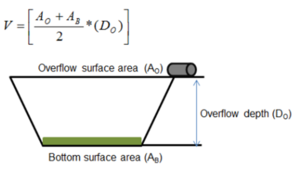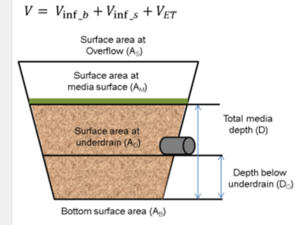
Requirements, recommendations and information for using bioretention BMPs in the MIDS calculator
Below is a summary of requirements, recommendations and other information for using the Minimal Impacts Design Standards (MIDS) calculator for bioretention BMPs. Links to MIDS pages and the MIDS calculator are included at the bottom of this page.
Contents
Overview
The MIDS calculator includes bioinfiltration (bioretention with no underdrain) and biofiltration (bioretention with an underdrain) as BMP options. The user must input the impervious cover acreage draining to the BMP.
For bioinfiltration systems, the user must input the overflow surface area (the area of the BMP at the point where overflow occurs), the surface area of the bottom of the basin, and the depth of the basin (the depth between the overflow surface area and the bottom surface area). The volume that can be stored in the basin is equal to the basin depth times the average surface area of the basin ((overflow area + bottom surface area)divided by 2). Water is assumed to be instantaneously delivered to the basin (kerplunk method). In reality, water would be infiltrating as the basin fills. The total volume infiltrated is thus underestimated. The user must also input the underlying soil type (HSG A, B, C, or D) and the time required for drawdown (48 hours or in the case of trout streams, 24 hours). The user will encounter an error if the water stored in the BMP cannot drawdown in the required time.
For biofiltration systems (systems with an underdrain), the user must input the surface area at the overflow, the surface area at the media surface, the surface area at the underdrain, the surface area at the bottom of the system, the total media depth, and the depth below the underdrain (depth from the underdrain to the bottom of the BMP). If the underdrain is at the bottom of the system, the surface area at the underdrain will equal the bottom surface area and the depth below the underdrain will equal 0. The underlying soil and drawdown time are specified as with bioinfiltration. The user must specify the water holding capacity of the media (field capacity minus wilting point). As with bioinfiltration, runoff is delivered instantaneously to the BMP. Water is lost through infiltration below the underdrain, through infiltration out the sides of the basin, and through evapotranspiration. As with bioinfiltration, the calculation method underestimates actual infiltration because water is instantaneously delivered to the BMP. The user can specify that an impermeable liner exists at the bottom or on the sides of the basin, in which case infiltration will not occur and the only loss of water will be through evapotranspiration.
Bioinfiltration and biofiltration BMPs can be routed to other BMPs in the MIDS calculator (other than green roofs). All other BMPs in the calculator can be routed to bioinfiltration and biofiltration BMPs. The default retention volume is 1.1 inches for each individual rain event. This value can be changed by the user. The calculaotr will notify the user if the default is changed.
Total suspended solids (TSS), particulate phosphorus and dissolved phosphorus loads and reductions in loading are calculated using event mean concentrations (EMCs) Default EMCs are 54.5 milligrams per liter for TSS and 0.3 milligrams per liter for total phosphorus (particulate plus dissolved). These can be changed by the user. The calculaotr will notify the user if the default is changed.
For bioinfiltration systems, all TSS and phosphorus captured by the BMP are reduced from the overall load delivered to the BMP. Note that more water may be delivered to the BMP than can be stored in the BMP. Excess water bypasses the BMP and receives no treatment from the BMP.
Requirements
- 3 foot separation from the bottom of the bioretention system to the seasonal high water table
- Use the most restrictive infiltration rate within 3 feet of the bottom of the BMP
- Drawdown time of 24 hours when the discharge is to trout streams
- For measured infiltration rates, apply a safety factor of 2
- Pretreatment
Recommendations
- 5 acres or less for contributing area
- Maximum ponding depth of 18 inches, reduced to 6 inches if there is no site information
- Field tested infiltration rates rather than table values
Information
- Guidance on determining infiltration rates
- Information on site constraints (shallow soil, karst, etc.)
- Information on assessing BMPs
- Information on design metrics (high flow bypass, ponding depths, drawn down)
- Guidance on pretreatment
- Information on soil mixes
- Plant information, including species list that show water tolerance, potential effects of different species on infiltration rates, planting guidance
- Construction specifications
- Information on operation and maintenance of bioretention BMPs.
Links to MIDS pages
- Performance goals for new development, re-development and linear projects
- Flexible treatment options
- Ordinance goals
- MIDS calculator
Related pages
- Overview for bioretention
- Types of bioretention
- Design criteria for bioretention
- Construction specifications for bioretention
- Operation and maintenance of bioretention
- Cost-benefit considerations for bioretention
- External resources for bioretention
- References for bioretention
- Requirements, recommendations and information for using bioretention BMPs in the MIDS calculator



